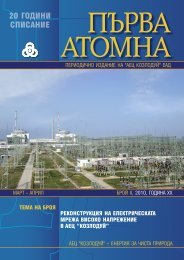Summary Report for Conduct of Kozloduy NPP Stress Tests
Summary Report for Conduct of Kozloduy NPP Stress Tests
Summary Report for Conduct of Kozloduy NPP Stress Tests
Create successful ePaper yourself
Turn your PDF publications into a flip-book with our unique Google optimized e-Paper software.
“<strong>Kozloduy</strong> <strong>NPP</strong>” PLC<br />
SUMMARY REPORT<br />
<strong>for</strong> <strong>Conduct</strong> <strong>of</strong> <strong>Kozloduy</strong> <strong>NPP</strong><br />
<strong>Stress</strong> <strong>Tests</strong><br />
To increase the reliability and reduce potential <strong>of</strong> total loss <strong>of</strong> power supply to OSY 400 kV,<br />
the system is designed as double section busbar system.<br />
To increase the reliability <strong>of</strong> Units 5 and 6 with power <strong>of</strong> 1000 MW is principle <strong>of</strong> its<br />
connection to 400 kV side by logic “two circuit breakers <strong>for</strong> connection” has been adopted.<br />
2.5.3.2.3 Loss <strong>of</strong> safety systems power supply<br />
3 batteries are provided per one <strong>for</strong> the three trains <strong>of</strong> the safety systems. The batteries<br />
operate in continuous charging mode with their charging provided from rectifiers constituting a<br />
UPSS compound. According to [7],[8] the batteries are charged <strong>for</strong> at least 2 hours (to 3 hours <strong>for</strong><br />
new batteries) at maximum load (<strong>for</strong> AC voltage – in inventors). Based on the tests per<strong>for</strong>med it<br />
was identified that the batteries last over 10 hours at real load [83].<br />
2.5.3.2.4 Loss <strong>of</strong> category II emergency power supply sources<br />
The required inventories <strong>of</strong> fuel and oil <strong>for</strong> continuous operation <strong>of</strong> emergency sources <strong>of</strong><br />
category II power supply are provided as follows, [45]:<br />
- DGS-5,6 from safety systems: general operational fuel inventory ensures continuous<br />
operation <strong>of</strong> each DG <strong>for</strong> at least 3 days;<br />
- DDG-5,6: 70 hours’ operation ensured;<br />
- Diesel pumps in CPS-3,4: 24 hours’ operation <strong>of</strong> all pumps (8) simultaneously;<br />
- DG “Emergency preparedness”: 8 hours’ continuous operation <strong>of</strong> DG at nominal load<br />
without charging.<br />
2.5.3.3 Loss <strong>of</strong> ultimate heat sink<br />
Essential components service water supply system design does not provide <strong>for</strong> specific<br />
measures to maintain cooling water supply.<br />
In the essential components service water supply system principles <strong>of</strong> redundancy, physical<br />
separation and independence <strong>of</strong> the trains is adopted.<br />
For units 5 and 6 six spray pools are built. The system trains operate by a closed circuit with<br />
water cooling in the spray pools. Each spray pool is designed to remove all the heat generated in an<br />
accident mode <strong>of</strong> the unit and to ensure service water temperature <strong>for</strong> essential components cooling<br />
within the range from +4°С to +33°С. in selection <strong>of</strong> the sizes <strong>of</strong> the spray pools, level change from<br />
1.5 m ensures group A service water supply system operation without filling <strong>of</strong> the pool with wind<br />
speed up to 2 m/s <strong>for</strong> 30 hours.<br />
Normal and emergency makeup <strong>of</strong> the spray pools is provided. The makeup is provided<br />
from normal electric pumps and in case <strong>of</strong> loss <strong>of</strong> external power supply from diesel pumps. The<br />
77/202

















